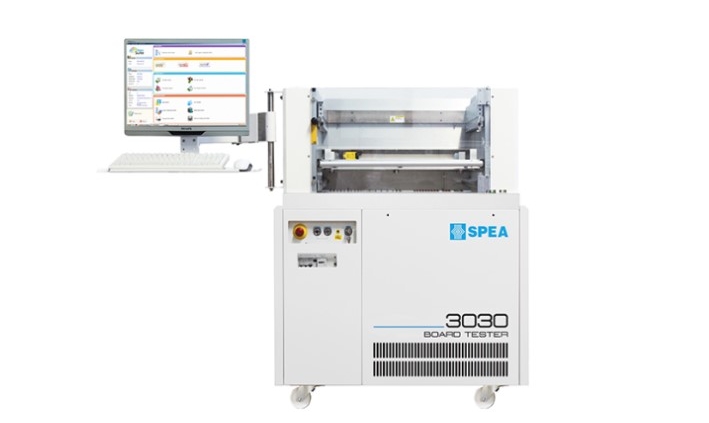Small footprint, high fault coverage
Highlights
- 2-fold parallel test
- Low space requirement
- Parametric high-speed ICT
- Automatic application development
- Wide range of test methods: ICT, FKT, flashing
Compact. Powerful.
The SPEA 3030 Compact is designed for fast and cost-effective in-circuit testing. With a small footprint, it offers maximum testing possibilities. The tester has a modular design, can be configured to customer specifications and, thanks to the dual-core parallel tests, it enables twice the throughput of conventional ICT testers with 100% fault coverage.
Parallel tests
The SPEA 3030 Compact can be configured as a multi-core system with up to 2 independent cores – each with independent CPU, local memory and instrumentation.
Reduce testing costs
The multi-core architecture drastically reduces testing costs. You only need one tester, one handling procedure, one adapter and one PC to test two assemblies simultaneously.
PC-independent architecture
With the PC-independent architecture of the SPEA 3030, the test program runs in the tester’s CPU and the test speed is determined by this. This also ensures that PC background programs do not affect the test speed. In addition, the PC can be updated or replaced at any time without having to debug test programs again.
Reduction of field returns
Reduction of field returns – The SPEA 3030 Compact was developed to help electronics manufacturers ensure the quality of their products. By using innovative test techniques, the SPEA 3030 Compact reliably finds faults that cannot be detected by conventional ICT testers.
Parallel flashing of several components
The SPEA 3030 Compact can be equipped with one or more flashing modules. This allows both identical and different components to be programmed in parallel. Flashing times and costs are significantly reduced.
Precise contacting with receivers from SPEA
The contacting units are integrated directly into the test system. This means that there are no interfering cables between the system modules and the adaptation. Signal integrity is guaranteed. The test system and adaptation are supplied by SPEA as a reliable and cost-effective turnkey test solution.
The contacting of the assembly is safe and precise. With the electromechanical SPEA drawer receiver, the contact pressure speed can be set specifically for the test specimen.
The lowering is always absolutely planar. The contacting level is freely programmable in steps of 100 µm. This allows different contacting levels to be realized, for example for 2-stage contacting during the function test.
Parametric ICT at maximum speed
The parametric-dynamic high-speed ICT of the SPEA 3030 Compact checks the parameters of each individual component according to the data sheet. These tests are generated automatically with the help of component libraries. This means short program creation times, short test times and maximum error coverage rates.
Testperformance
- True-Per-Pin architecture
SPEA’s direct pin electronics guarantee reliable testing of complex analog or digital assemblies. When not multiplexed, the pin electronics provide a completely independent stimulus and measurement channel on each channel (1:1). This offers several advantages: faster test generation, simple ECO management, full flexibility. - Open pin detection
Two different test techniques are available to clearly identify unsoldered pins (open pins) and other process faults: Electro Scan and Junction Scan. - Function test
The SPEA 3030 Compact not only offers functional tests at component level, but also at cluster and board level. Parameterization is carried out in the Leonardo system software or optionally using higher programming languages such as Microsoft C++, Visual Basic, Borland, Delphi, LabView, etc. - Customizable & flexibly retrofittable
The uncompromising flexibility of our testers guarantees an individual configuration that optimally meets the respective test requirements. You can either configure your tester completely when you buy it or upgrade it gradually – anything is possible. Third-party measuring instruments can also be easily integrated.
The wide range of adaptation options, such as drawer receivers, plug interfaces, inline contacting units, pylon interfaces and also customer-specific interfaces or third-party receivers (Genrad, Ingun, Zentel, etc.), are outstanding. - Boundary Scan
Boundary Scan is used when physical access to individual circuit parts is not possible. This means that highly complex assemblies, fine-pitch technology, multilayers and BGAs can be tested without direct contact with the test probes. The parallel use of boundary scan technology and the system modules of the SPEA 3030 Compact enables broader fault coverage while at the same time reducing adapter costs (virtual test points instead of real test needles).
Transfer of test programs and adapters to other testers
The SPEA testers are based on a common system architecture. The hardware and software platform is designed so that test programs and adapters can be transferred from one system to another. For the test programs, this applies not only within the SPEA 3030 system family, but also between board and flying probe testers. This enables the greatest possible flexibility in production.

